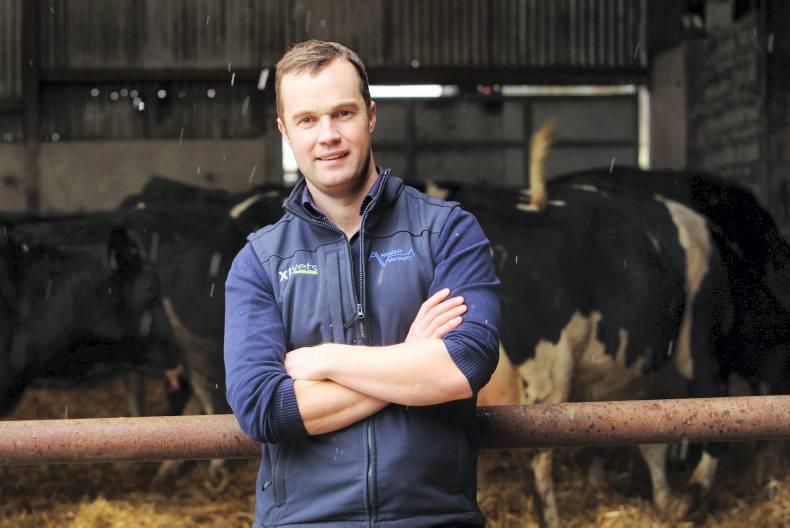In the last week I have seen the effects of magnesium deficiency in a cow and a case in two sheep in the one flock. Although we are not theoretically in the classic risk period, we are certainly coming into it. This is definitely an emergency call as time is limited when it comes to treatment. One of the sheep I saw was dead and the other one was down with paddling legs and severe muscles tremors. The ewe responded to sedation, IV calcium and magnesium given under the skin.
The cow was more unusual as she was off her milk completely in the evening and seemed to have signs of meningitis. When I arrived she was still standing but beginning to show muscle twitching and hyperaesthesia (overreaction to sound and touch). On exam, her heart rate was very fast and could be heard without a stethoscope. She was hyper-excitable and quite aggressive, which can often be the case in the early stages of grass tetany. We ruled out infection and nervous ketosis straight away. She responded well again to IV calcium and magnesium given under the skin. The farmer rang in two hours to say she had completely settled down.
Due to the fact grass tetany (low blood magnesium - Mg) is a veterinary emergency, it helps to identify it quickly and also, most importantly, take actions to prevent it. The effects of the deficiency are so severe because Mg plays a role at the nerve-muscle junction, almost like a link. A deficiency can lead to muscle failure and cardiac arrest.
Looking out for signs
The clinical signs are similar in cattle and sheep. Frequent isolation from the herd or flock, with muscle tremors, hyperaesthic to sound and movement and frequent urination. This can progress rapidly to animals going down and paddling of all four legs. Cows will often have dilated pupils (staring) and also frothing from the mouth.
These cases really are veterinary emergencies. I always recommend suspect cases be given both magnesium and calcium under the skin immediately when spotted.
Tip: I always advise warming Mg and Ca infusions to body temperature before being given to speed up the absorption into the bloodstream.
Other conditions that may look like tetany include milk fever, nervous ketosis and acute meningitis.
Due to the severity of the disease, these animals can often be found dead. To diagnose these cases, we can sample fluid from the eye (aqueous humour) to check Mg levels.
Why is this deficiency so severe in ruminants?
Cows and sheep both require continuous daily amounts of magnesium in their diets. Magnesium is also be hugely dependent on potassium (K) levels for its absorption.
Due to increased digestive transit times and low levels of Mg, early spring or fresh grass periods present a risk for both cattle and sheep. This is of course precipitated by the extra demands of milk production in the ewe and the cow at this time of year.
It is also worth noting that any periods of stress can precipitate the problem. We sometimes see this at weaning time in the suckler cow.
So, as we face into a potential risk period for grass tetany, it is always worth looking at supplementing magnesium or adding it to the diet to match shortfalls that may occur. Always look at risks for metabolic disease and try preventing it by taking action at flock or herding level.
Read more
Vet’s corner: Tommy’s tips for 10 ailments
Vet’s corner: a whole herd emergency
In the last week I have seen the effects of magnesium deficiency in a cow and a case in two sheep in the one flock. Although we are not theoretically in the classic risk period, we are certainly coming into it. This is definitely an emergency call as time is limited when it comes to treatment. One of the sheep I saw was dead and the other one was down with paddling legs and severe muscles tremors. The ewe responded to sedation, IV calcium and magnesium given under the skin.
The cow was more unusual as she was off her milk completely in the evening and seemed to have signs of meningitis. When I arrived she was still standing but beginning to show muscle twitching and hyperaesthesia (overreaction to sound and touch). On exam, her heart rate was very fast and could be heard without a stethoscope. She was hyper-excitable and quite aggressive, which can often be the case in the early stages of grass tetany. We ruled out infection and nervous ketosis straight away. She responded well again to IV calcium and magnesium given under the skin. The farmer rang in two hours to say she had completely settled down.
Due to the fact grass tetany (low blood magnesium - Mg) is a veterinary emergency, it helps to identify it quickly and also, most importantly, take actions to prevent it. The effects of the deficiency are so severe because Mg plays a role at the nerve-muscle junction, almost like a link. A deficiency can lead to muscle failure and cardiac arrest.
Looking out for signs
The clinical signs are similar in cattle and sheep. Frequent isolation from the herd or flock, with muscle tremors, hyperaesthic to sound and movement and frequent urination. This can progress rapidly to animals going down and paddling of all four legs. Cows will often have dilated pupils (staring) and also frothing from the mouth.
These cases really are veterinary emergencies. I always recommend suspect cases be given both magnesium and calcium under the skin immediately when spotted.
Tip: I always advise warming Mg and Ca infusions to body temperature before being given to speed up the absorption into the bloodstream.
Other conditions that may look like tetany include milk fever, nervous ketosis and acute meningitis.
Due to the severity of the disease, these animals can often be found dead. To diagnose these cases, we can sample fluid from the eye (aqueous humour) to check Mg levels.
Why is this deficiency so severe in ruminants?
Cows and sheep both require continuous daily amounts of magnesium in their diets. Magnesium is also be hugely dependent on potassium (K) levels for its absorption.
Due to increased digestive transit times and low levels of Mg, early spring or fresh grass periods present a risk for both cattle and sheep. This is of course precipitated by the extra demands of milk production in the ewe and the cow at this time of year.
It is also worth noting that any periods of stress can precipitate the problem. We sometimes see this at weaning time in the suckler cow.
So, as we face into a potential risk period for grass tetany, it is always worth looking at supplementing magnesium or adding it to the diet to match shortfalls that may occur. Always look at risks for metabolic disease and try preventing it by taking action at flock or herding level.
Read more
Vet’s corner: Tommy’s tips for 10 ailments
Vet’s corner: a whole herd emergency










SHARING OPTIONS